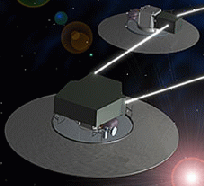Next Application


A team of engineers at Hernandez Engineering in Houston and at Brigham Young University have experimented with using Chained Lin-Kerninghan to optimize the sequence of celestial objects to be imaged in a proposed NASA Starlight space interferometer program. The goal of the study it to minimize the use of fuel in targeting and imaging maneuvers for the pair of satellites involved in the mission (the cities in the TSP are the celestial objects to be imaged, and the cost of travel is the amount of fuel needed to reposition the two satellites from one image to the next). A report of the work is given in the paper "Fuel Saving Strategies for Separated Spacecraft Interferometry".